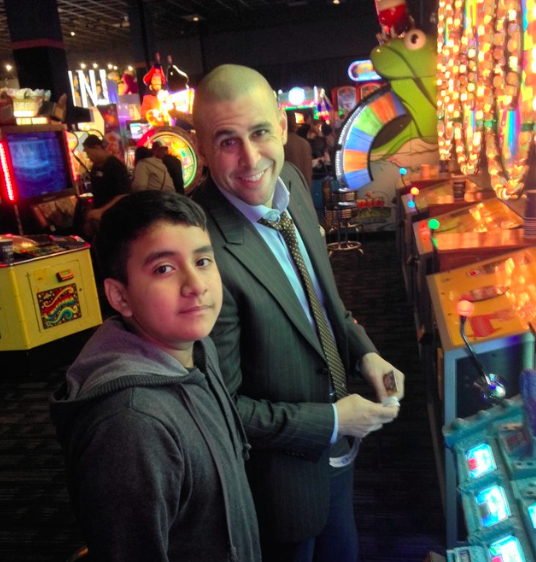Mentoring in the age of inequality
For the past year, I’ve been writing a book on mentoring and, as I pull together the many threads of history, social policy, and research, an interesting picture is emerging. One that raises uncomfortable questions about mentoring in the age inequality.
Mentoring as a field can trace its lineage to the progressive era politics of early 1900’s, and the growing American discomfort with wealth inequality, which had characterized the preceding 30 years. Even now the stars of this gilded age (e.g., Rockefeller; Carnegie; Vanderbilt) remain familiar, but there were growing demands for more progressive tax policies, a breakup of monopolies, and an end to the corrupting influence of money in American politics. Under the leadership of President Theodore Roosevelt, a national spirit of citizenship and charity had taken hold, and young businessmen had become ad hoc champions of the less advantaged boys of their cities. Within this zeitgeist, volunteers rarely thought that a lack of grit, self-esteem, motivation, or any internal attribute was the root cause of their mentees’ struggles. More frequently, they saw delinquency and other problems as symptoms of grinding poverty, exploitive child labor practices, crowded immigrant family tenements, Jim Crow laws, and the yawning gaps in wealth and opportunity. Consequently, Big Brothers often behaved more like social workers than the once-a-week, lighter touch volunteers of today. In fact, the nation’s original “Big Brother,” Irv Westheimer, didn’t even begin helping his mentee, Tom, until he had stabilized the boy’s family.
Broad public support for more equitable economic policies extended through much of the 20th Century, during which many families enjoyed rising wages and wealth security and, by the 1930’s, a narrowing of the gap between the rich and poor. But, beginning in the late 1970s, many factors, including a decline in American industrial jobs, a flattening of average wages, a renewed influx of money into politics, and the growth of information technology conspired to create a long, steady decline in the middle class. Reagan era reductions in income taxation and consequent retrenchment in welfare redistribution helped to further widen the inequality gap.
 And, as was the case at the turn of the century, the broader social and economic context influenced approaches to mentoring . By the late 1980’s, with poverty and social problems on the rise, there was a clarion call for volunteer mentors and a rapid expansion of programs. But this time, it was not in the context of progressivism and concerns about rising income inequality. Instead, mentoring was seen as a relatively cost efficient way to address the needs of the growing ranks of youth who were being thrust into poverty while minimizing tax-intensive government expenditures on public education, health, housing and safety nets. Consistent with the times, the public embraced formulations and solutions that highlighted individual frailty and redemption over structural impediments and change. And, because mentoring located the problem (a lack of role models) and solution (deployment of predominately middle-class volunteers) at the personal level, it fit neatly popular notions of equal opportunity for upward mobility. Psychology’s growing attention to children’s attitudes and attributes aligned with this focus on the decontextualized child. Social psychologists refer to our tendency to focus on individual, dispositional factors and to deemphasize the social context as the fundamental attribution error. It draws our attention away from the profound opportunity gaps and structural inequalities, and from the cultivation of positive resources in children’s broader environments.
And, as was the case at the turn of the century, the broader social and economic context influenced approaches to mentoring . By the late 1980’s, with poverty and social problems on the rise, there was a clarion call for volunteer mentors and a rapid expansion of programs. But this time, it was not in the context of progressivism and concerns about rising income inequality. Instead, mentoring was seen as a relatively cost efficient way to address the needs of the growing ranks of youth who were being thrust into poverty while minimizing tax-intensive government expenditures on public education, health, housing and safety nets. Consistent with the times, the public embraced formulations and solutions that highlighted individual frailty and redemption over structural impediments and change. And, because mentoring located the problem (a lack of role models) and solution (deployment of predominately middle-class volunteers) at the personal level, it fit neatly popular notions of equal opportunity for upward mobility. Psychology’s growing attention to children’s attitudes and attributes aligned with this focus on the decontextualized child. Social psychologists refer to our tendency to focus on individual, dispositional factors and to deemphasize the social context as the fundamental attribution error. It draws our attention away from the profound opportunity gaps and structural inequalities, and from the cultivation of positive resources in children’s broader environments.
Consequently, whereas Westheimer first helped to stabilize his mentee’s family and then opened his social network to his mentee, the focus of the modern mentoring movement has been squarely on the child. To the extent that families and communities are considered, they are generally seen as the benign or even risky backdrop to the mentor and youth dyad. With a few notable exceptions (e.g., Professor Renee Spencer, Thomas Keller), the role of parents and families has also been largely absent from the research literature on formal youth mentoring. The same goes for children’s neighborhoods and schools—which are often seen as problems to escape rather than settings to strengthen and cultivate (Hurd & Albright, 2016; Schwartz & Rhodes, 2016).
Ernest Coulter, another key founder of Big Brothers, once wrote that a society that “warps, thwarts, and denies the future citizen basic rights is to blame,” and that “every crowded, ill-ventilated tenement is a tax upon the future.” He urged people to see the society, not just the child, as “delinquent.” Such critiques were less risky when they aligned with the prevailing sentiments of the times. But the modern day mentoring movement was launched and continues to operate during a period of rising inequality, and formulations that privilege individual deficits over structural impediments. Of course, much has improved in our society and our mentoring programs over the past 40 years. But, as we celebrate our successes in mentoring, we must also retain the courage to challenge the forces of inequality.











